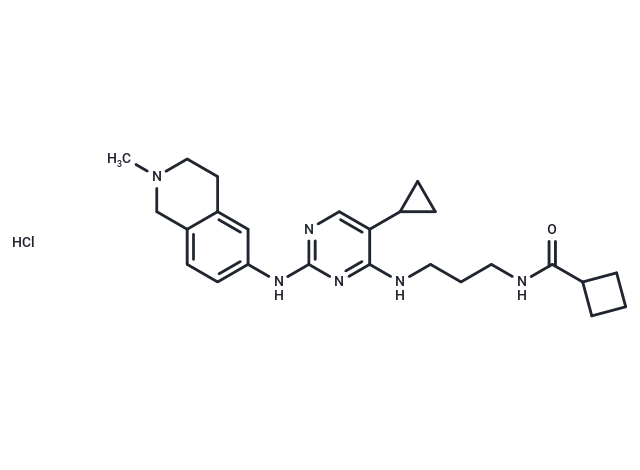Shopping Cart
- Remove All
 Your shopping cart is currently empty
Your shopping cart is currently empty

MRT68921 hydrochloride is a potent inhibitor of both ULK1 and ULK2 [IC50s: 2.9 and 1.1 nM, respectively].

| Pack Size | Price | Availability | Quantity |
|---|---|---|---|
| 1 mg | $37 | In Stock | |
| 5 mg | $60 | In Stock | |
| 10 mg | $95 | In Stock | |
| 25 mg | $198 | In Stock | |
| 50 mg | $358 | In Stock | |
| 100 mg | $446 | In Stock |
| Description | MRT68921 hydrochloride is a potent inhibitor of both ULK1 and ULK2 [IC50s: 2.9 and 1.1 nM, respectively]. |
| Targets&IC50 | ULK1:2.9 nM, ULK2:1.1 nM |
| In vitro | MRT68921 is the most potent inhibitor of both ULK1 and ULK2, with greater than a 15-fold reduction in the IC50 for ULK1 (2.9 nM) and greater than a 30-fold reduction for ULK2 (1.1 nM). MRT68921 (1 μM) was sufficient to reduce phospho-ATG13 to control levels, and in line with the in vitro IC50 values [1]. Pre-incubating the cells for 30 min with the ULK1 inhibitor MRT68921 at the optimal concentration of 100 nM prevented the forskolin-induced CYTO-ID staining. The same effect was observed with siRNA against ULK1 [2]. |
| Kinase Assay | Initial ULK1 kinase assays were performed with GST-ULK1, produced in Sf9 cells. For other experiments, recombinant GST-ULK1 (wild type, kinase-dead (K46I), and M92T and M92Q) was expressed in 293T cells, purified, and eluted from a glutathione-Sepharose column. Kinase assays were carried out in 50 mM Tris-HCl, pH 7.4, 10 mM magnesium acetate, 0.1 mM EGTA, and 0.1% β-mercaptoethanol, containing 30 μM cold ATP, and 0.5 μCi of [γ-32P]ATP for 5 min at 25 °C. Prior to ATP addition, reaction mixes were prewarmed to 25 °C for 5 min. Reactions were stopped by the addition of sample buffer, followed by SDS-PAGE, transfer to nitrocellulose, and analysis by autoradiography and immunoblot. For IC50 curve measurements, kinase assays were performed, using myelin basic protein as a substrate [1]. |
| Cell Research | Immortalized wild-type mouse embryonic fibroblasts (MEFs) have been described previously. MEFs and 293T cells were grown in DMEM, supplemented with 10% fetal bovine serum and penicillin/streptomycin, and cultured at 37 °C, 5% CO2. For induction of autophagy, cells were typically grown to 75% confluency, washed twice, and incubated in Earle's balanced salt solution (EBSS) for 1 h (or complete medium as a control) unless indicated. MRT67307 (10 μM), MRT68921 (1 μM), AZD8055 (1 μM), or bafilomycin A1 (50 nM) was included where indicated. Transfection and transduction were as described [1]. |
| Molecular Weight | 471.04 |
| Formula | C25H34N6O·HCl |
| Cas No. | 2070014-87-6 |
| Smiles | Cl.CN1CCc2cc(Nc3ncc(C4CC4)c(NCCCNC(=O)C4CCC4)n3)ccc2C1 |
| Relative Density. | no data available |
| Storage | Powder: -20°C for 3 years | In solvent: -80°C for 1 year | Shipping with blue ice. | ||||||||||||||||||||
| Solubility Information | DMSO: 4.71 mg/mL (10 mM), Sonication is recommended. H2O: 10 mg/mL | ||||||||||||||||||||
Solution Preparation Table | |||||||||||||||||||||
DMSO
| |||||||||||||||||||||

Copyright © 2015-2024 TargetMol Chemicals Inc. All Rights Reserved.